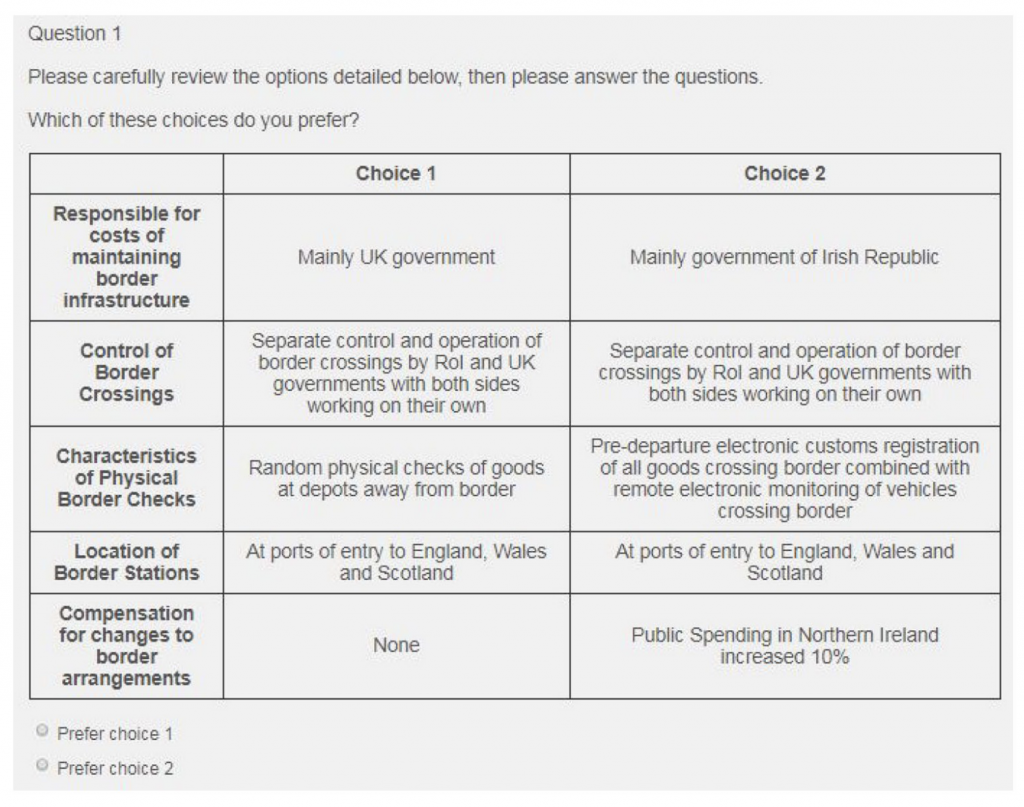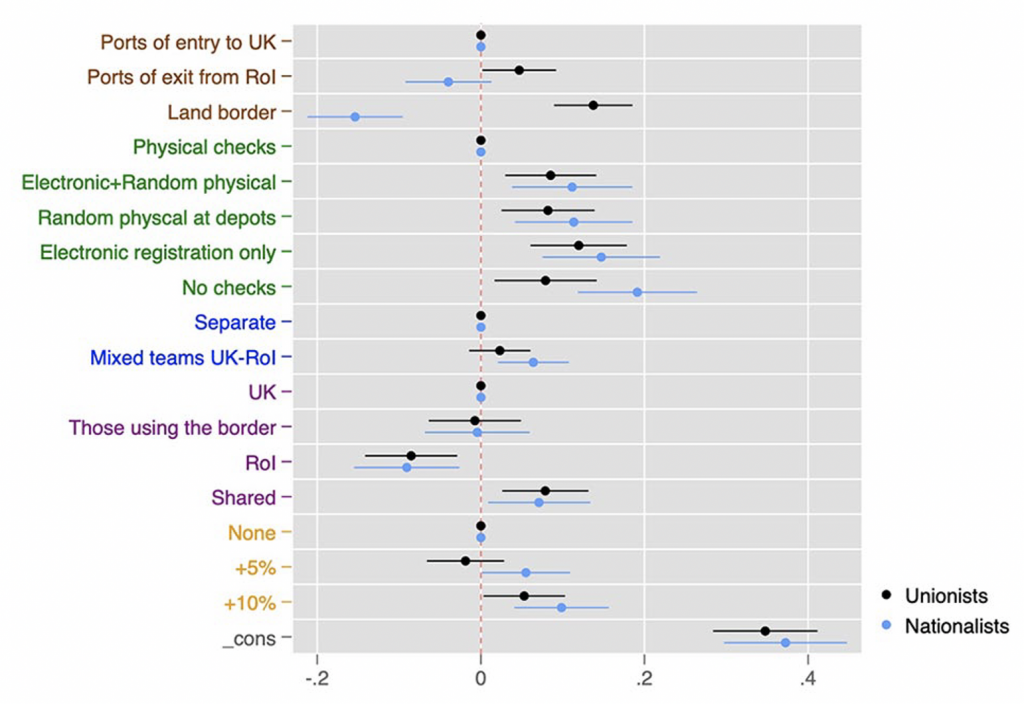Edward Morgan-Jones, Laura Sudulich, Feargal Cochrane and Neophytos Loizides discuss the findings of research on the opinions of the different communities of Northern Ireland about border arrangements. They find that the preferences of unionist and nationalist citizens were much more convergent than was apparent at the political party elite and governmental levels during the Brexit negotiations.
As the most recent dispute about the practical implementation of the EU-UK withdrawal agreement illustrates the politics of Northern Irish border remains central to the politics and policymaking of Brexit. The question of whether physical and regulatory barriers are placed in the Irish sea between the rest of the UK and the Republic of Ireland, or at the land border between Northern Ireland and the Republic of Ireland is fraught and consequential. Whatever arrangements policy makers settle on will have implications for the peace process, economy and wider politics and relations between the component parts of the UK and the EU.
A crucial and difficult to investigate question is public opinion about the regulation of this border. Borders are multidimensional institutions entailing choices about where they are located and the kinds of barriers they created. Public opinion on borders is often difficult to capture using conventional political survey questions, since these typically do not allow us to investigate the trade-offs and compromises that choices about border arrangements entail. For example, borders can differ in the intrusiveness of their inspections, the location of check points, the financial costs they impose on users and the legal jurisdiction into which they fall.
Our research – using a special type of survey experiment called conjoint analysis, carried out in May and June 2018 – mapped out areas of convergence and divergence in the preferences about post-Brexit border arrangements of unionist and nationalist communities, simulated the degree of public support for politically plausible outcomes, and identified the border arrangements that both communities can agree upon. Our key findings are, at that at the time the survey was taken, that there were wide areas of consensus across Northern Ireland’s communities across many aspects of border arrangements. In particular, there was agreement on the importance of keeping the transaction costs of crossing the border low. Where communities differed was with respect to the location of the border – with nationalists preferring the customs border operate on an East-West basis (between the rest of the UK and the Republic of Ireland) while the unionists would prefer that this border operate on North-South basis on the land border between Northern Ireland and the Republic.
Nevertheless, despite these differences, our simulations of support for different possible agreements indicated that there was potentially majority support for compromises across different dimensions. In both communities there was support for an East-West border with some intrusive border checks if there was sufficient compensation. We also found there was very little support across communities for a no-deal outcome that might see intrusive border checks on the North-South land border.
These results flowed from a survey of a sample of 759 respondents from the Qualtrics Northern Irish Online Panel, comprising the unionist and nationalist communities, as well as citizens who did not identify with either group. In this survey, respondents were presented with pairs of hypothetical border agreements and asked to choose one. Each agreement had five attributes mirroring the key dimensions of the future border arrangements to be agreed: location of border stations; characteristics of border checks; monitoring of border crossings; responsibility for the costs of maintaining border infrastructure; compensation for changes to border arrangements.
Table 1 reports the list of dimensions and Figure 1 shows an example of paired choices. Overall, respondents saw four pairs of border settlements in separate screens and were asked to make a choice between the two options in each.
Figure 1: Sample pair of border arrangements
Critically, while all respondents were exposed to the same dimensions, the values attached to each dimension were randomised. For example the border location was randomised from one settlement option to another. We were then able estimate the effect of these values on the likelihood that a particular border arrangement would be chosen and thus the importance of this element to respondents’ preferences over different border options. The results of this analysis are visualised in Figure 2. In this figure we show the preferences of different communities for the different border options. Where each dot and associated confidence interval overlap between communities, the figure show consensus where their diverge shows differences between communities. What we see in this figure is consensus on most aspects of boarder arrangements except for the location of the border.
Figure 2: The effect of border arrangements on Northern Irish respondents by community
The picture presented above is one of relative agreement across the two communities along multiple dimensions. In other words, there is scope for bilateral support for a solution, despite the expected cross-community divergence on where the border should be located. To identify what solutions would secure support – overall and by community – we simulated different combinations of border arrangements and estimated the support they would get by community and overall.
In Table 2, we present the results of simulations of a range of potential arrangements that might be considered politically realistic. This gives a feel for the practical consequences and the level of popular support when border attributes are varied. The main takeaway from this table is the relative low support across the communities of a No Deal solution and that there is majority support in each community for an East-West solution with compensation. This is something that perhaps contributes to Unionist politicians coming to terms with the proposed East-West arrangement before the recent controversy.
Our work also identifies a number of elements relevant to the work of public representatives, civil servants, and negotiators. Firstly, preferences of unionist and nationalist citizens for post-Brexit border arrangements were much more convergent than was apparent at the political party elite and governmental levels during negotiations. Secondly, Northern Irish citizens were very concerned about keeping the economic cost of crossing the border low. Therefore, both unionists and nationalists were prepared to compromise on solutions with low border crossing costs. Third, this study has repercussions on the current post-Brexit border arrangements that are likely to be similarly granular and contextual in nature. Public support will depend on how an East–West border in the Irish Sea is mitigated in practice; future research could explore how preferences change in response to the experience of these arrangements.
________________________
Note: the above draws on the authors’ published work in Research & Politics.
About the Authors
 Edward Morgan-Jones is Reader in the School of Politics and International Relations at the University of Kent.
Edward Morgan-Jones is Reader in the School of Politics and International Relations at the University of Kent.
 Laura Sudulich is Reader in the Department of Government at the University of Essex.
Laura Sudulich is Reader in the Department of Government at the University of Essex.
 Feargal Cochrane is Emeritus Professor of International Conflict Analysis at the University of Kent.
Feargal Cochrane is Emeritus Professor of International Conflict Analysis at the University of Kent.
 Neophytos Loizides is Professor in International Conflict Analysis at the University of Kent.
Neophytos Loizides is Professor in International Conflict Analysis at the University of Kent.











